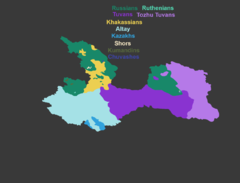History
In the onset of the Second Russian civil war, anarchist militias rose up in the republics of Tuva, Altai and Khakassia. They were successful in capturing a few villages, but were quickly stalled.
At the same time, ![]() Michail Millerov, an ethnic Don Cossack from Ukraine, was leading an anarchist militia in Ukraine, fighting off against the Russian Army, the Lwów People's Republic and the NATO-backed nationalist Ukrainian State.
Michail Millerov, an ethnic Don Cossack from Ukraine, was leading an anarchist militia in Ukraine, fighting off against the Russian Army, the Lwów People's Republic and the NATO-backed nationalist Ukrainian State.
The anarchists in Tuva called for help from the militia as well as the BOAK. Both organisations accepted the offer and took the first train to Kyzyl. In the city's train station ![]() Millerov declared that "The united anarchist front will establish order without parasitism."
Millerov declared that "The united anarchist front will establish order without parasitism."
Throughout the latter half of 2028, the United front, commonly referred to as "The Black Army", fought against Chinese forces, the remnants of the Republis of Tuva and Buryatia, and, allegedly, a Zabójcy Zła division[1], locked in a truce with the Federated Communes of Siberia and Nerestumorya.
The army almost took Omsk once, but were beaten back. After the defeat, the UABA retreated to the Altai and proceeded to develop the nation, effectively leaving the war.
During the war, ![]() Millerov earned himself the title of "Açay", which means the same as "Baťko" did in relation to
Millerov earned himself the title of "Açay", which means the same as "Baťko" did in relation to ![]() Nestor Makhno - the father of freedom in the region.
Nestor Makhno - the father of freedom in the region.
![]() Millerov effectively created the policy of "Anarchism in one Country", with how isolationist the new Free Territory was. More work was put into rebuilding the land and establishing free, cooperation-based institutions.
Millerov effectively created the policy of "Anarchism in one Country", with how isolationist the new Free Territory was. More work was put into rebuilding the land and establishing free, cooperation-based institutions.
Society
The conflict, referred to as "The Liberation Struggle" in the Free Territory, brought about a "Buddhist renaissance" in the area. A lot of soldiers from the UABA converted to Buddhism, including ![]() Millerov himself. He also learned Tuvan and Mongolian to show that he is just like the locals, equal to them.
Millerov himself. He also learned Tuvan and Mongolian to show that he is just like the locals, equal to them.
The new society also brought about a new-old art style: Buddhist Futurism.
Everything from education to economy is regulated regionally, using local worker unions and councils. "Kiosk culture" was promoted, increasing the amount of "Kiosks" - small stores that sell everything from newspapers to snacks to condoms.
Demographics

The population of Uriankhai is estimated to be around 2 million as of 2040. There is no set dominant ethnic group. The amount of Kazakhs and Ruthenians in the area increased because of refugees, Kazakhs fleeing from China and Ruthenians from the PSNR. Strangely enough, little to no Uighur refugees were noted.
The average age in Uriankhai is 34.
Army
The UABA still exists, but most of it's members already live normal lives. There is no mandatory service or conscription, and membership is voluntary.
The army is organised along the "Cossack system". Each division has a certain level of autonomy. The divisions are based along ethno-linguistic lines.
The current divisions are:
 The Army of the Altai - 50K
The Army of the Altai - 50K
- Tuvan Free Army
- Gorno-Altai Corpus
- Khakass Free Army
- Mongol Corpus
- Kazakh Corpus
- "Buddha" Buryat-Mongol Legion
 BOAK - 20K
BOAK - 20K
- Russian Corpus
- Belarusian Revolutionary Action
 "Nestor Makhno" Special Cavalry Legion - 15K
"Nestor Makhno" Special Cavalry Legion - 15K
- Ukrainian Forces
- Don Host
- Kuban Host
- Terek Host
 Foreign Legion - 60K
Foreign Legion - 60K
- Chinese Black Dragon Army
- "Proudhon" French Legion
- "D'Annzunzio" Italian Legion
- "New Struggle" Polish Corpus
- "John Brown" American Army
- Total:145K
- ↑ A ZZ commander claimed he engaged the UABA 70 km south of Ulan-Ude.